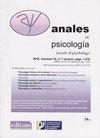西班牙养老院老年人的社会和情感孤独:一项横断面研究
IF 1.3
4区 心理学
Q3 PSYCHOLOGY
引用次数: 0
摘要
孤独感会影响身体和心理健康,但在养老院(NHs)却鲜有研究。我们的目的是分析来自西班牙加泰罗尼亚中部5个NHs的65名居民的整体、社会和情感孤独相关因素,并验证其普遍性。样本中81.5%为女性,平均年龄84±7.13岁。横断面研究包括65岁或以上的老年人,并保持认知状态。采用De Jong Gierveld孤独感量表评估整体孤独感及其亚型;并收集了社会人口学和健康相关变量。双变量和多变量分析分别采用卡方检验和logistic回归。总体孤独患病率为70.7% (95%CI:58.2-81.4),社交孤独患病率为44.6% (95%CI: 33.1-56.6),情感孤独患病率为46.2% (95%CI: 34.5-58.1)。总体孤独与较低的感知生活质量(比值比-OR = 5.52, 95% CI:1.25-24.38)和国家资助的NHs相关(OR = 0.19, 95% CI: 0.05 - 0.74);有0-1个孩子的社交孤独(OR = 0.25, 95% CI: 0.08 - 0.77),情绪孤独伴抑郁(OR = 4.54, 95% CI: 1.28-16.08)和尿失禁(OR = 4.65, 95% CI: 1.23-17.52)。近71%的居民存在孤独感,孤独感与NH类型和较差的生活质量有关,与情绪抑郁和UI有关,与少于2个孩子的社交相关。La soledad, poco estudiada en las residencias de ancianos, puede afectar a La salud física y mental。新设计的目标是模拟社会因素、社会因素、全球因素、社会因素和情感因素,共计65名居民,其中5名居民居住在Cataluña Central (España),并通过comprobar su患病率。La muestra estuvo formada为81.5%,mujeres为84±7.13 años。El estudio横向incluyó a adultos mayores de 65 años y con estado cognitivo preservado。参见utilizó la Escala de Soledad de de Jong Gierveld para evaluation la Soledad general by sus subtipos;我们将识别变量sociodemográficas与其他变量的关系联系起来。Se utilizó la prueba de chi-cuadrado (o de Fisher) y la regresión logística para el análisis分别为双变量和多变量。La prevalencia de La soledad global fue del为70.7% (IC 95%: 58.2-81.4), La soledad social del为44.6% (IC 95%: 33.1-56.6), La soledad emotional del为46.2% (IC 95%: 34.5-58.1)。La soledad global se asoció conuna menor calidad de vida percibida(比值比-OR = 5.52, IC 95%: 1.25-24.38)与las residencias concertadas(比值比-OR = 0.19, IC 95%: 0.05-0)。74);1例为社交障碍(OR = 0.25, IC 95%: 0.08 ~ 0.77), 2例为情绪障碍depresión (OR = 4.54, IC 95%: 1.28 ~ 16.08), 3例为尿失禁(UI) (OR = 4.65, IC 95%: 1.23 ~ 17.52)。La soledad estuvo通过以下方式呈现了71%的失落居民:asoció通过pepecalidad de vida获得了el tipo de residencience, depresión通过La La calidad de vida获得了情感上的支持,通过La La IU获得了社交上的支持。本文章由计算机程序翻译,如有差异,请以英文原文为准。
Social and emotional loneliness among older people living in Nursing Homes in Spain: a cross-sectional study
Loneliness, little studied in Nursing Homes (NHs), can affect physical and mental health. We aimed to analyze the factors associated with overall, social, and emotional loneliness in 65 residents of 5 NHs from Central Catalonia (Spain), and to verify its prevalence. The sample consisted of 81.5% women with a mean age of 84±7.13 years. The cross-sectional study included older adults aged 65 or over and with preserved cognitive status. De Jong Gierveld Loneliness Scale was used to assess overall loneliness and its subtypes; and sociodemographic and health-related variables were collected. The chi-square (or Fisher’s) test and logistic regression were used for bivariate and multivariate analysis respectively. Prevalence of overall loneliness was 70.7% (95%CI:58.2-81.4), social loneliness 44.6% (95% CI: 33.1-56.6) and emotional loneliness 46.2% (95% CI: 34.5–58.1). Overall loneliness was associated with lower perceived quality of life (Odds Ratio-OR = 5.52, 95% CI:1.25-24.38) and NHs with state subsidized places (OR = 0.19, 95% CI: .05-.74); social loneliness with having 0-1 children (OR = .25, 95% CI: .08-.77), and emotional loneliness with depression (OR = 4.54, 95% CI: 1.28-16.08) and urinary incontinence (UI) (OR = 4.65, 95% CI: 1.23-17.52). Loneliness was present in almost 71% of residents and was associated with type of NH and poorer quality of life, the emotional with depression and UI and the social one with having less than 2 children. La soledad, poco estudiada en las residencias de ancianos, puede afectar a la salud física y mental. Nuestro objetivo es analizar los factores asociados a la soledad global, social y emocional de un total de 65 residentes de 5 residencias de la Cataluña Central (España), y comprobar su prevalencia. La muestra estuvo formada por 81.5% mujeres con una edad media de 84±7.13 años. El estudio transversal incluyó a adultos mayores de 65 años y con estado cognitivo preservado. Se utilizó la Escala de Soledad de De Jong Gierveld para evaluar la soledad general y sus subtipos; y se recogieron variables sociodemográficas y relacionadas con la salud. Se utilizó la prueba de chi-cuadrado (o de Fisher) y la regresión logística para el análisis bivariante y multivariante, respectivamente. La prevalencia de la soledad global fue del 70.7% (IC 95%: 58.2-81.4), la soledad social del 44.6% (IC 95%: 33.1-56.6) y la soledad emocional del 46.2% (IC 95%: 34.5-58.1). La soledad global se asoció con una menor calidad de vida percibida (Odds Ratio-OR = 5.52, IC 95%: 1.25-24.38) y las residencias concertadas (OR = 0.19, IC 95%: 0.05-0. 74); la soledad social con tener 0-1 hijos (OR = 0.25, IC 95%: 0.08-0.77), y la soledad emocional con la depresión (OR = 4.54, IC 95%: 1.28-16.08) y la incontinencia urinaria (UI) (OR = 4.65, IC 95%: 1.23-17.52). La soledad estuvo presente en casi el 71% de los residentes y se asoció con el tipo de residencia y la peor calidad de vida, la emocional con la depresión y la IU y la social con tener menos de 2 hijos.
求助全文
通过发布文献求助,成功后即可免费获取论文全文。
去求助
来源期刊

Anales De Psicologia
医学-心理学
CiteScore
3.30
自引率
5.90%
发文量
57
审稿时长
4-8 weeks
期刊介绍:
Anales de Psicologia / Annals of Psychology is a multidisciplinary journal of the various thematic areas of scientific psychology. It publishes original research articles and theoretical review in any of its basic, applied and methodological areas included within psychology.
Publishing, financing, marketing and distribution corresponds Editum: Editions of the University of Murcia (Spain). The organizational guidelines and editorial policies come from the Editorial Team (elected for four years by the Areas and / or Departments of Psychology at the University of Murcia) and the Editorial Board, composed of scholars and experts from different universities and institutions national and international. It is published in print (ISSN: 0212-9728) since 1984 and in Internet publishing (web) (ISSN: 1695-2294) since 2000. Available online full text in pdf from the vol. 1 1984.
Anales de Psicologia / Annals of Psychology maintains a system of exchange with other journals and publications of psychology in the world. Through an free exchange agreement with their respective publishers or entities responsible for editing, these journals and publications are received at the University of Murcia (Biblioteca "Luis Vives", near the Faculty of Psychology) and in return, our journal is sent to libraries and educational and research institutions such centers responsible for editing.
 求助内容:
求助内容: 应助结果提醒方式:
应助结果提醒方式:


